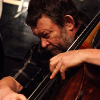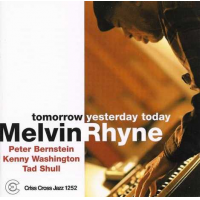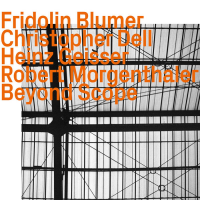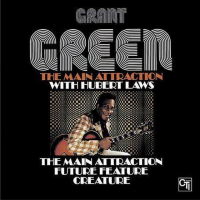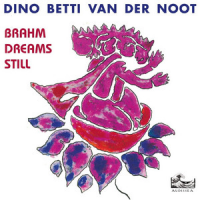Home » Jazz Articles » Liner Notes » Peter Erskine Trio: As It Was
Peter Erskine Trio: As It Was
Erskine's early career couldn't have been more diametric to the majority of the fifteen ECM releases on which he would participate over a twelve-year period, either as a leader or band member, when he first came to ECM Records in 1985 as part of two highly regarded groups, each with their own recording debut. 1986's Current Events was the first of four recordings with guitarist John Abercrombie's newly minted trio, also featuring double bassist Marc Johnson, while Bass Desires, Johnson's own leader debut from the same year, was a quartet record that, with the bassist and Erskine joined by John Scofield and Bill Frisell, quickly redefined the possibilities of a twin-guitar lineup over the course of two acclaimed recordings.
The drummer first came to attention as a member of 1970s big bands led by Maynard Ferguson and Stan Kenton, before achieving greater successs with the pan-cultural Weather Report during its most successful period. Erskine joined Weather Report at its commercial zenith in 1978, continuing to record and tour with the group until 1982.
By the time he came to ECM in 1985, Erskine was moving towards an approach that placed greater value on space and subtle interaction over groove and percussive gymnastics. With the Bass Desires band acting as the bridge, it was Erskine's work in two trios— Abercrombie's, and the one-off collective with Norwegian saxophonist Jan Garbarek and Czech double bassist Miroslav Vitous, responsible for 1991's Star—that preceded and prepared the drummer for his own trio with Taylor and Danielsson, two musicians already well-known to fans of the label by the time they joined Erskine to record You Never Know in the sum-mer of 1992.
Danielsson first established himself in two 1970s quartets with Jan Garbarek and Norwegian drummer Jon Christensen. The first, with fellow Swede, pianist Bobo Stenson, released 1973's Witchi-Tai-To and 1975's Dansere, two lauded albums recently collected together with an earlier Garbarek/ Stenson collaboration, 1991's Sart, in the 2012 Old & New Masters Edition box, also called Dansere. The second was an even more successful and critically acclaimed quartet under the leadership of pianist Keith Jarrett. First heard on the 1974 studio set Belonging, the recently unearthed archival live recording Sleeper: Tokyo, April 16, 1979 (2012) may, perhaps, be the finest document of Jarrett's "European Quartet."
In both groups, Danielsson managed the perfect confluence of unshakable, deeply resonant and ever-reliable anchor with muscular, intuitive and intrinsically singable melodic foil. He continued to bring these qualities to subsequent ECM recordings across three decades, working with artists ranging from Tunisian oudist Anouar Brahem (1994's Khomsa), Argentinean bandoneonist Dino Saluzzi (2001's Responsorium) and the late percussionist/sitarist Collin Walcott (1997's Grazing Dreams), to Italian trumpeter Enrico Rava (1975's The Pilgrim and the Stars), Finnish drummer Edward Vesala (I977's Satu) and Polish trumpeter Tomasz Stańko (1997's Litania), amongst others.
Taylor first came to ECM with Azimuth, the unconventionally configured trio which, also featuring trumpeter Kenny Wheeler and singer Norma Winstone, released five recordings, from I977's eponymous debut through 1995's How It Was Then... Never Again.
His compositions and performances were instantly recognizable across recordings that, in addition to his one and only ECM album as a leader (2002's Rosslyn), also included those by label mates Wheeler (1990's The Widow in the Window), Garbarek (1977's Places), Vitous (1982's Journey's End), Norwegian bassist Arild Andersen (1981's Molde Concert), American violinist Mark Feldman (2006's What Exit) and British reed multi-instrumentalist John Surman (1993's Stranger Than Fiction), amongst others.
But it was Erskine's rapid growth, playing in Abercrombie's trio and the trio with Vitous and Garbarek, that rendered the ultimate collaboration with Taylor and Danielsson under the drummer's leadership possible. "It was with John Abercrombie that I learned how to drop so many of the playing devices that were limiting my ability to listen and interact,"explains Erskine."I was tired of how I was playing and sounding. I needed to change and to grow. I wanted to like what I heard. I call it 'anti-drumming' sometimes, or 'less is more,' but to do that, one has to learn a lot about listening, playing with intention, and being specific with each choice... all while being 'free.'"
"I developed my most trusting, dependent relationship with Marc Johnson, Erskine continues. "We spent a lot of time on the road together, both struggling (and enjoying the struggle ... or the process) to get closer to the 'bone' of the music while freeing up both ourselves and the resultant music-making. A lot of gig post-mortems and discussions, with avid analysis of other rhythm sections."
Towards the end of Erskine's four-record run with Abercrombie's trio—Current Events followed by Getting There (1988); the live John Abercrombie / Marc Johnson / Peter Erskine (1989); and the paradigm shift of November (1993). with guest John Surman, where every objective Erskine had been setting for himself seemed to suddenly and completely gel—the drummer also found himself recording and touring with Garbarek and Vitous.
Beyond the preparation that both trios provided for Erskine when he was invited to make a recording under his own name, the final piece in the puzzle was time spent as a member of Kenny Wheeler's quintet and big band—specifically the expat Canadian trumpeter's two 1990 ECM releases: Music for Large & Small Ensembles, and The Widow in the Window. These recordings, in addition to featuring Abercrombie and Taylor, also included bassist Dave Holland, subsequently replaced by Palle Danielsson (though the Swedish bassist would never appear on any Wheeler recordings). During live performances, there were invariably a couple of points each night when Taylor, Danielsson and Erskine would play as an unadorned trio, and so its continuation seemed almost an inevitability.
"The trio seems, by its mathematical and geometric natures, to offer the most possibilities where interaction meets form, and openness meets density, "Erskine explains. "That said, I found myself hamstrung (and somewhat ham-fisted) in piano trios that relied upon the Oscar Peterson or Bill Evans model; something about most piano players' left hands that seemed to box the music in somehow. I'll peg that up to my limitations and relative immaturity in knowing how to play and thrive in the piano trio format. In any event, I found myself drawn to non-piano trios.
"But the 'letting go' or art of surrender that I experienced and learned while working with Abercrombie and Johnson, and then with Garbarek and Vitous, prepared me for the piano trio with John and Palle," Erskine continues. "Making an ECM album with a piano trio was a bit of a gamble for me. I was not in any sort of comfort zone, aside from that provided by working with two geniuses, as well as with [label head and producer] Manfred [Eicher] and Jan-Erik [Kongshaug, the renowned engineer at Oslo's Rainbow Studios, where all four albums in this box set were recorded]."
"I won't say that we brought out the best in each other." Erskine recalls, "but I will say that we drew out our most explorative and interesting from each other. Without trying to be, we were a truly unique group. I've heard nothing like it before or since. If the trio with Abercrombie and Johnson was my university, where I got my Masters' degree in drumming, then the trio with John and Palle was where I earned my Doctor of Musical Arts."
Nowhere is this clearer than on "New Old Age," the dark-hued, free-spirited and mystery-filled opening track on You Never Know. On this gradually unfolding, nine-minute Taylor composition, the pianist begins alone, laying out its foundational premise, with Erskine waiting a full ninety seconds before entering—and when he does enter, it's with the sparest, most delicate, textural cymbal work. All the more unexpected from a group with the drummer's name topping the mar-quee, it instantly sets the trio's playing field. In-the-moment spontaneity is predicated, paradoxically, on oftentimes complexly designed harmonic contexts that challenge all three band members to continually reassess and redefine the balance of this most flexible of musical triangles. It also defines a collective modus operandi based equally on attention to space, nuance and detail: the absolute epitome of placing the music's needs ahead of any individual participant's.
"The recording captured some wonderful conversations and it seemed like everyone had something good to say, "Erskine says. "New Old Age" made clear, from the get-go, that this was a trio with its own approach, its own voice. And while Taylor provided the greatest number of original compositions to the set, it's Erskine's sole contribution—the deceptive "On the Lake," its melodic motif inspired by "Julia," from The Beatles' White Album—that is, perhaps, most emblematic of this trio's way of doing things. A series of thirteen two-note fragments played first on piano alone, then supported by the sparest but most intuitively perfect bass notes and delicate cymbal work, it's only when Erskine moves to brushes, as Taylor and Danielsson open the composition up to a series of simple changes and short solos, where the bassist demonstrates his inimitable combination of sinewy muscle and intrinsic melodism, while Taylor delivers a master class in dynamics to make his own solo similarly sing.
Despite shifting meters, a relentless array of changes and a series of challenging starts and stops, Taylor's "Clapperclowe" ultimately became a thrilling regular in the trio's live sets, as Erskine seamlessly shifts from near-whisper cymbals to more fully propulsive kit work. Danielsson solos, with more rhythmic intent, in tandem with Erskine, who then delivers his most impressive feature of the set, while Taylor shines as a player of such graceful sophistication that he manages to seamlessly weave a motif-driven improvisation in, out and around this knottiest of compositions with threading-a-needle precision.
As atmospheric, dark and impressionistic as much of You Never Know is, if there were any doubt about Erskine, Danielsson and Taylor's allegiance to "the jazz tradition," the record ends with the trio's one and only standard. Cole Porter's elegant "Everything I Love," is delivered with grace and, yes, swing, by a trio that comes out of the gate as fully formed and impressive a piano trio as existed at the time ... and since. A trio whose collective resume and influences reflect the Transatlantic, transcultural nature of three musicians growing up in three very different countries and three very different contexts ... but brought together with a singular sense of purpose.
If Taylor is You Never Know's biggest compositional contributor—with 15 of the 37 pieces making up the trio's repertoire credited to the pianist, its most prolific writer by a long shot, rendering him a significant definer of the group's overall complexion—it was still very much Erskine's trio, with the drummer defining two particular cornerstones upon which it was to be founded.
"I was very specific that: number one, dynamically, the goal was to get audiences to lean forward in their seats to hear us; and number two, most importantly, that we think of and consider solos to be non-events. I was trying to create more non-events than events—that the arc of the tune didn't need any visible peaks. When we began to tour after recording You Never Know, the solos on certain tunes, like my 'On the Lake,' were getting too muscular. So I told the guys, 'Just imagine that you're riding on a train, and you glance out the window and through some trees you see a lake and you see some mist there; just that fleeting impression. I don't need a flock of geese to fly by,"' Erskine says, laughing. "These guys were my musical elders but they were good sports about it. Everyone was polite enough to listen to each other and to what the music had to say; the trio operated out of a very high sense of mutual listening and respect."
In addition to the eight compositions he contributed to the trio's repertoire, Erskine also sourced other material, most notably from Vince Mendoza, already a familiar ECM face for his 1990 collaboration with John Abercrombie and Jon Christensen, Animato. Having already worked with Erskine for a few years, the composer/arranger seemed a natural recruit, though adapting his idiosyncratic, at times mathematically driven and generally more orchestral music to such a reduced context was no small challenge.
Dark and often pensive, Mendoza's three contributions to You Never Know—the shimmering "Amber Waves," brighter "She Never Has a Window" and episodic "Heart Game"—provide a surprising contrast to Taylor's denser, more oblique (and curiously titled) "Pure & Simple" and "Evans Above"—which, beyond the titular homage to one of Taylor's early influences, possesses little resemblance to pianist Bill Evans in its layered detail and shifting compositional constructs, while respecting its source by expanding and modernizing Evans' turning the piano trio into a three-way conversation.
Still, irregularly metered, thickly harmonized and relentlessly change-driven, As It Is' buoyant Mendoza contribution "Esperança" remains eminently approachable, thanks to Taylor's instinctive melodic weave throughout its compositional constructs, conjoining elegant simplicity with the occasional light-speed burst of virtuosity, while Erskine closes the relatively brief piece with an ostinato-driven solo, his cowbell playing a central role before opening up the entire kit to draw the piece to its inevitable conclusion.
Elsewhere on As It Is, Erskine reintroduces his arrangement of William Walton's "Touch Her Soft Lips And Part," previously heard on his 1991 album Sweet Soul. Pared down to a trio, this gorgeously simple song becomes even more poignant, with Taylor's gently majestic playing supported by Erskine and Danielsson, who had, by this time—with two prior albums and a couple of years of extensive touring beneath their collective belt—evolved into a group that truly spoke with a single voice, shifting gears with near-telepathic empathy.
As simpatico as the trio had become, however, artistic differences began to emerge by Juni."I was trying to get to more of a folk-oriented place, with simpler song forms and trying to trust the music that much more," says Erskine. "That just wasn't where John was interested in going, and I respected that. He was a brilliant guy, full of ideas, and he just wasn't turned on by that kind of aesthetic direction.
"None of the albums were particularly easy" Erskine continues. "Still, somehow, we all felt that our expectations were being met. Aesthetically there was hardly ever any disagreement, but there would always be a tune or two where John—because he had the arranging abilities, the harmonic abilities and the sense of responsibility—would take it upon himself to rework something, and so he'd come in on the second day or later the same afternoon, and say, 'Here, I've re-sketched this.' So it's stating the obvious, but I can't overemphasize how much the success of this music bears John Taylor's stamp."
If Juni was a difficult record to make, it's not obvious from the result—though it is the trio's most abstract recording. Three Taylor tunes (the spacious, oblique "Prelude No. 2," more propulsive "Windfall" and indigo "Fable"), two from Erskine (the free-wheeling "The Ant & The Elk" and similarly open-ended "Twelve," which goes from apparent freedom to some of the trio's fiercest swing) and a rare contribution from Danielsson (the abstract, rubato, feather-light "Siri") are augmented by two outside contributions (Kenny Wheeler's waltz-time "For Jan" and Diane Taylor's tone poem, "Namasti"). Overall, it suggests a shift towards a freer direction within the context of more challenging constructs—a contrast to where Erskine was looking to go.
Across the span of four recordings, Erskine, Taylor and Danielsson created a body of work that, twenty years later, remains as engaging, explorative and vital as it was when first conceived.
"A structural engineer examining the bottom of our house for earthquake/structural integrity told me that a building he'd just inspected was one of the most sound and safe he'd ever seen ... because it was all triangles," Erskine says. "Structurally, you can't design anything stronger than a triangle, because of the dynamic of opposing forces. I don't think it is just a linguistic coincidence or taking advantage of the word triangle to look at it in musical terms. It does work; there's an incredible amount of maneuverability and agility yet complete strength with a trio. And because our trio was not over-arranged, because we did not plan out the highs and lows, that's why I think we touched people and why it remains an adventure to hear."
The trio's non-confrontational approach continues to resonate for other reasons that are, perhaps, even more significant now than they were two decades ago. "The world has gotten so noisy and things have gotten so dense and assaultive," Erskine says."People really are grateful for a chance to rest their ears, rest their spirits, rest their psyches ... and to be challenged in ways that refresh those parts of the brain and spirit that have become wired to shut off."
Liner Notes copyright © 2026 © ECM Records GmbH 2016. Used by permission of ECM Records, Munich..
As it Was can be purchased here.
Contact John Kelman at All About Jazz.
With the realization that there will always be more music coming at him than he can keep up with, John wonders why anyone would think that jazz is dead or dying.
Track Listing
CD1 (You Never Know): New Old Age; Clapperclowe; On The Lake; Amber Waves; She Never Has A Window; Evans Above; Pure & Simple; Heart Game; Everything I Love. CD2 (Time Being): Terraces; For The Time Being; If Only I Had Known; Evansong; Page 172; Liten Visa Till Karin; Bulgaria; Ambleside; Phrase One; Palle's Headache; Pieds-en-l’air. CD3 (As it Is): Glebe Ascending; The Lady In The Lake; Episode; Woodcocks; Esperança; Touch Her Soft Lips And Part; Au Contraire; For Ruth; Romeo & Juliet. CD4 (Juni): Prelude No.2; Windfall; For Jan; The Ant & The Elk; Siri; Fable; Twelve; Namasti.
Personnel
Album information
Title: As it Was | Year Released: 2016 | Record Label: ECM Records
Tags
PREVIOUS / NEXT
Peter Erskine Concerts
Support All About Jazz
 All About Jazz has been a pillar of jazz since 1995, championing it as an art form and, more importantly, supporting the musicians who make it. Our enduring commitment has made "AAJ" one of the most culturally important websites of its kind, read by hundreds of thousands of fans, musicians and industry figures every month.
All About Jazz has been a pillar of jazz since 1995, championing it as an art form and, more importantly, supporting the musicians who make it. Our enduring commitment has made "AAJ" one of the most culturally important websites of its kind, read by hundreds of thousands of fans, musicians and industry figures every month.




